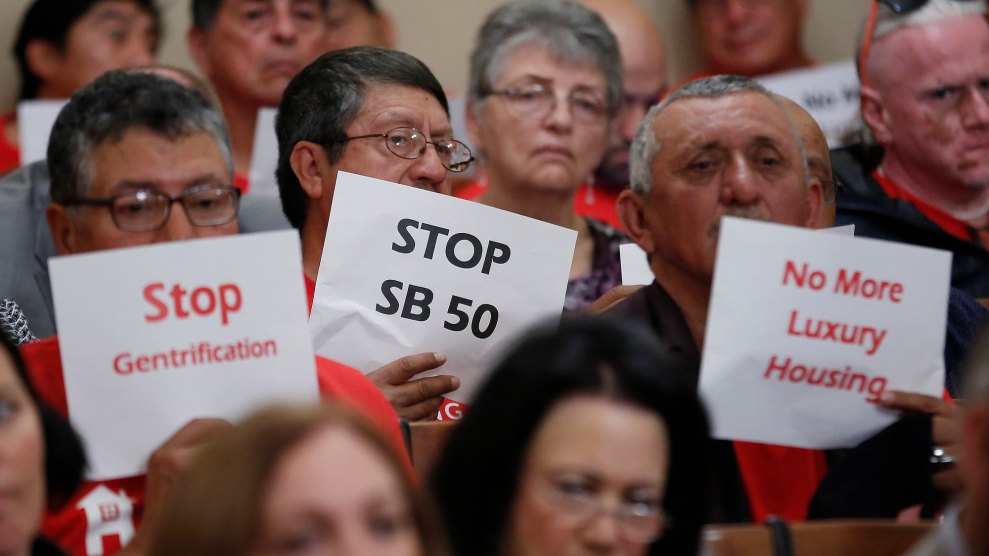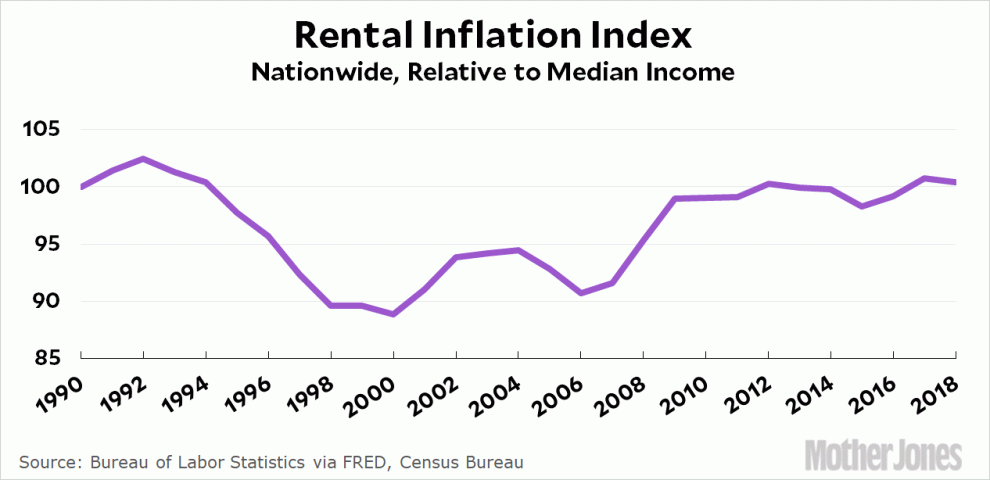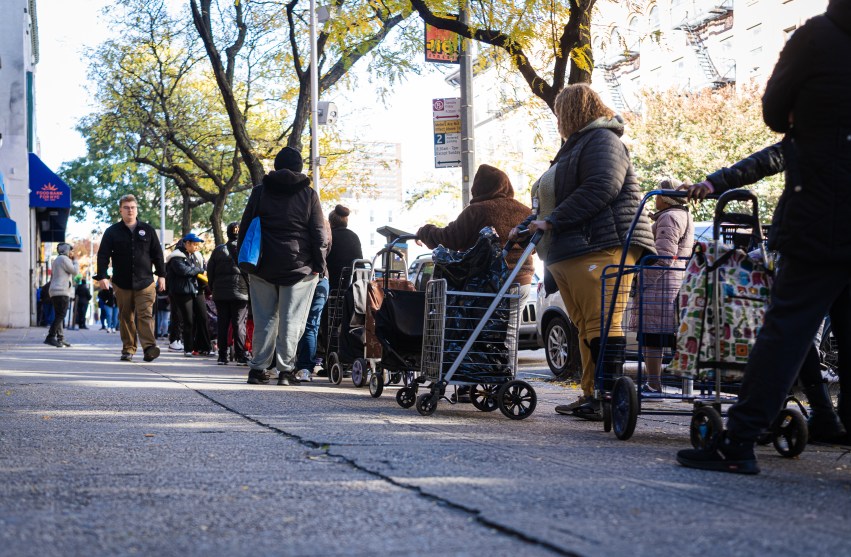
Opponents of SB 50 gather as lawmakers discuss the bill in Sacramento, California.Rich Pedroncelli/AP
“Everyone hates SB 50—everyone hates it,” said California state Sen. Scott Wiener at a recent forum on the state’s housing crisis. “You hear people getting upset about it, yelling about it, coming down to City Hall and yelling.” Flanked by real estate developers and housing rights advocates, Wiener, a Democrat who represents San Francisco, had come to discuss his ideas for solving the problem—which meant talking about the heated reaction to his signature piece of legislation, Senate Bill 50—the housing bill Californians seem to love to hate.
Everyone agrees that California is facing a housing crisis. Rents and home prices are soaring: The median home price in the San Francisco Bay Area is $830,000; in Los Angeles County it’s almost $600,000. Homelessness is increasing: Nearly a quarter of the nation’s homeless population lives in California. Low-income residents are being displaced by the wealthy: More than half of all home buyers in San Francisco last year work in the software industry. And there just isn’t enough housing to go around. Wiener likes to cite a report by McKinsey that found that California has 3.5 million fewer homes than it needs.
“The fundamental problem is that we have a massive housing shortage, which explodes housing costs and which puts enormous pressure on tenants in particular because the rents go so high,” Wiener told me just before the forum. “We have to lessen that pressure by adding more housing of all varieties at all incomes.” SB 50 is his attempt to expand the housing market to allow for faster, bigger, and denser residential construction. It’s an idea that many people agree with in the abstract, but in trying to make a workable plan, Wiener has grabbed one of the third rails of California politics.
SB 50’s opponents have called it “an act of war on homeowners” and “a Trojan horse for big developers’ profits.” One housing rights group said it would cause “Negro removal.” While complaining about the bill, the vice mayor of Beverly Hills likened pro-housing “Sacramento politicians” to the Old Testament villain Haman. Politicians from SF to LA worry the bill would undermine local housing plans; suburban NIMBYs don’t want apartment buildings in their neighborhoods; and housing rights activists lambast the bill’s “trickle-down” approach, which they say will only further fuel gentrification.
At SB 50’s core is “upzoning,” overriding local zoning laws that prohibit higher-density housing construction in residential areas. Currently, zoning requirements in 80 percent of California forbid building anything other than single-family residences (with some allowances for in-law units). SB 50 would open up some of those areas—particularly those near major transit hubs, job clusters, and good schools—to higher-density residential construction. Developers would be allowed to build taller buildings with more units, with a requirement that a certain number must be rented below market rate.
The bill’s critics say it would not make a real dent in housing prices. “What the Wiener bill really is about is raising housing opportunities for highly skilled, relatively high-income people,” said Michael Storper, a professor of urban planning at the University of California-Los Angeles. SB 50 is built on the assumption that the market will react to upzoning by building more housing. That’s true, said Storper, but he warns that “the market will respond in the areas where the price of the construction is met by an effective market demand—a return on its investment.” And that means housing for the well-off.
Upzoning cannot change the high cost of building, nor can it make lower-income neighborhoods more desirable to developers, said Storper. “It will gentrify what’s left to gentrify in the highly desirable areas,” he predicted.
Opponents of SB 50 point to Chicago, where smaller-scale, targeted upzoning laws did not lead to the expected boom of new units. As a recent study found, real estate speculation soared and housing and land prices increased in the upzoned areas. Another study found that upzoning in New York City further fueled the displacement of minority and working-class residents. Its authors recommended that upzoning needs to be balanced with policies to prevent displacement. Francisco Dueñas, the housing campaign director at the Alliance of Californians for Community Empowerment, said, “We think that in general, similar to what happened in Chicago, [SB 50] is just going to increase the value of that land, fueling greater speculation, and then that gets translated into increased rent and more people getting pushed out.”
“If anything, this would lightly create the conditions for more luxury housing for neighborhoods that don’t necessarily need them,” said Rene Christian Moya, director of Housing is a Human Right, a branch of the AIDS Healthcare Foundation. (In April, the AHF sent out mailers attacking Wiener, comparing SB 50 to the urban renewal policies that author James Baldwin had called “Negro removal.” In response, Wiener called AHF a “fake non-profit” with “zero credibility.”)
Despite the vitriol and backlash, Wiener says he is optimistic about his bill’s chances. “When you actually look at polls on SB 50…it consistently polls well,” he said. A poll from April found that 61 percent of Californians support SB 50. In February, a poll by the San Francisco Chamber of Commerce found that 74 percent of people in the city supported the bill. Its broad range of supporters includes groups like the California Labor Federation and the California Chamber of Commerce, as well as the California League of Conservation Voters, Habitat for Humanity, and the Non-Profit Housing Association of Northern California.
Wiener says his desire to tackle the housing crisis is personal. Before his career in politics, he did pro-bono legal work for renters, defending clients facing no-fault evictions in San Francisco. “Seeing the terror that they were living in, saying things to me like, ‘If I lose my apartment I will have to leave San Francisco and leave my whole community behind.'” Later, as part of his neighborhood association, he saw the glacial pace of the approval process for building housing that was “100 percent within zoning.”
In 2011, he was elected to the San Francisco Board of Supervisors. Housing costs in the city had always been high, but around then they went “through the roof—everything exploded.” One story sticks out to him: “I was walking down the street where I lived, and my neighbor, an older gentleman, said, ‘Scott, I’m really scared.’ And I said, ‘Why are you scared?’ And he said, ‘My landlord is painting my building.’ Normally, as a tenant, you should be thrilled that your landlord is painting your building, but immediately he saw that as a sign that he was going to sell the building, which meant he was going to be evicted.”
Wiener’s first housing bill, which he introduced last year, met a quick and fiery demise. It lacked any meaningful affordability standards and didn’t make it out of its first committee hearing. Wiener took the criticism to heart, tweaked the bill to add protections for renters and to set up affordability requirements, and reintroduced it as SB 50 in December. It has passed through two committees and is now slated for the Senate Appropriations Committee in mid-May, its last hurdle before it can go to the Senate floor. California Gov. Gavin Newsom hasn’t weighed in on SB 50, but he has pledged to make up the state’s 3.5 million home gap by 2025.
Wiener says he understands the concerns about his approach. He’s also pared down one of the most controversial aspects of the original version of SB 50, which allowed developers to pay a fee that would go toward building affordable units elsewhere rather than build them into their projects. Those affordable units must be built nearby, said Wiener, and “the certificate of occupancy can’t be granted for the market rate units until the affordable project is underway.”
Unlike his previous bill, SB 50 allows “sensitive communities” at risk of displacement to opt out of its requirements for five years. It would not change existing affordability requirements in cities that have them. For cities that don’t, it mandates that between 15 and 25 percent of newly built units are below market rate, depending on the size of the project. But the bill’s critics say that won’t do enough for the Californians struggling the most to pay for housing. “If you just say you’ll build more with the current inadequate affordability protections, you’ll get more inadequately affordable housing,” said Storper. “It’s not Scott Wiener’s fault—the basic affordability provisions that he’s bringing into his bill are so bad that merely reproducing them will not change much anywhere.”
Wiener said there’s a fine line here: If you boost the number of affordable units that developers have to incorporate into their projects, it can make those projects financially unfeasible. “If you do that, then you end up with no housing and no affordable units,” he said. “So you try to find the sweet spot where you’re pushing the percentage as high as you can go without jeopardizing the project.”
Wiener’s detractors also point to his ties to the real estate and construction industries. The Action Center on Race and the Economy recently published a report that found that California’s real estate industry spent $110 million on lobbying and campaign spending since 2008. Some of the biggest spenders—the California Building Industry Association, the California Apartment Association, and the California Association of Realtors—have spent heavily against tenant protection measures and have also contributed to Wiener’s campaigns. “That’s part of the broader context,” said Dueñas. “The affordable housing organizations aren’t on a level playing field; we don’t have the money to lobby as much as market rate developers.” Wiener claims the donations don’t affect how he votes. Real estate and developers “contribute to a lot of members of the legislature, including members who aren’t supporting the bill,” he notes.
The larger problem, according to Storper, is that SB 50 doesn’t address the economic inequality that is the root of the California’s housing crisis. The only way to deal with it, he said, is through subsidies and public housing. “Inequalities of income plus urbanization are really toxic combos,” he said. “How deep is society’s commitment to dealing with [the crisis]?”
Wiener and his allies have continued to tinker with SB 50 as it moves through the capital. It will likely be bundled in a package of related bills. Its latest version has been amended to incorporate elements of a competing bill from state Sen. Mike McGuire, and a group of progressive lawmakers have introduced pro-tenant legislation to address rent gouging and evictions that may become part of the package.
Even if SB 50 passes, results may be a long way off. “When it comes to development and housing, nothing is fast,” Wiener said. “I think sometimes people have this perception that the governor signs a bill and, you know, the next day apartment buildings descend from the sky in people’s neighborhoods. It unfolds very gradually over time.” For people who have concerns about how it will change their communities, he highlights the bill’s slow rollout. For those who would like to see a lot more housing yesterday, he acknowledged, “it’s very frustrating.”
This article has been updated.

















